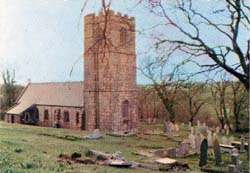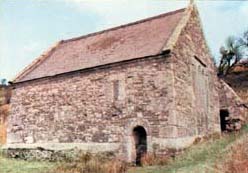| Natural History | 
| Parishes & Villages |
| Heritage | Tourist Information |
St Clether
 A small village beside the River Inney with the parish church standing some distance away. A little way on from the church following the river stands what is considered Cornwall's most beautifully situated Holy Well. There are over two hundred Holy Wells in Cornwall (indeed there is one on the next village - Laneast), however few can compere with the beauty and tranquillity of the well & chapel at St Clether (pictured below). Tucked away in complete isolation and only reachable by a footpath across a moorland meadow, the small chapel stands between the river and an outcrop of limestone rocks. The spring bubbles up behind the chapel and then the water flows under the altar and leaves the building to join the river below. Possibly originally built in the 5th Century by a Welsh saint named St Clederus the well was rebuilt in the 15th Century and restored in 1895.
A small village beside the River Inney with the parish church standing some distance away. A little way on from the church following the river stands what is considered Cornwall's most beautifully situated Holy Well. There are over two hundred Holy Wells in Cornwall (indeed there is one on the next village - Laneast), however few can compere with the beauty and tranquillity of the well & chapel at St Clether (pictured below). Tucked away in complete isolation and only reachable by a footpath across a moorland meadow, the small chapel stands between the river and an outcrop of limestone rocks. The spring bubbles up behind the chapel and then the water flows under the altar and leaves the building to join the river below. Possibly originally built in the 5th Century by a Welsh saint named St Clederus the well was rebuilt in the 15th Century and restored in 1895.
 A couple of miles down the road the village of Laneast was home to one of the moors most famous sons. John Couch Adams was born in the village where his father was a farmer in 1819. A brilliant scholar he went on to attend Cambridge where he eventually became a Fellow and Tutor at St John's college. Best known now determining the presence of Neptune (work which at the time was ignored) he did however become Professor of Astronomy to many universities and later President of the Astronomical Society. He was offered the position of Astronomer Royal but was too modest to accept and died in 1892 and buried close to Sir Issac Newtons grave in Cambridge.
A couple of miles down the road the village of Laneast was home to one of the moors most famous sons. John Couch Adams was born in the village where his father was a farmer in 1819. A brilliant scholar he went on to attend Cambridge where he eventually became a Fellow and Tutor at St John's college. Best known now determining the presence of Neptune (work which at the time was ignored) he did however become Professor of Astronomy to many universities and later President of the Astronomical Society. He was offered the position of Astronomer Royal but was too modest to accept and died in 1892 and buried close to Sir Issac Newtons grave in Cambridge.
| Local History | |
| John Couch Adams The story of how John Couch Adams discovered the presence of Neptune by applying Newtons laws of gravitation to the orbit of Uranus |
 |
| The Bodmin Moor Pages | ||||
|---|---|---|---|---|
| Natural History | Heritage | Welcome | Parishes & Villages | Tourist Information |
 |
The Bodmin Moor Pages are brought to you by |
 |
||
| www.southpenquite.co.uk | ||||